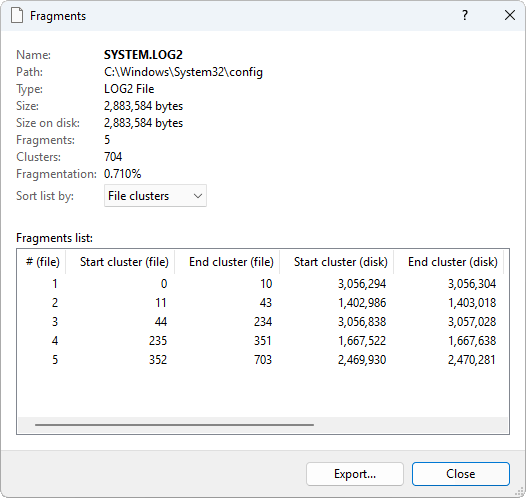Fragments dialog
Internally, NTFS treats folders as a special type of file. Therefore, the word file in this page indicates either a file or folder.
This dialog shows comprehensive information about a file, such as the list of the fragments the file consists of, the number of fragments and the internal fragmentation. To display the Fragments dialog, select File → Fragment information.

In the upper area of the dialog, you can see the following information about the file:
| Information | Description |
|---|---|
| Name | Displays the name of the file. |
| Path | Displays the path of the file. |
| Type | Displays the type of the file. |
| Size | Displays the actual size of the file. |
| Size on disk | Displays the actual amount of space being occupied by the file on the disk. |
| Fragments | Displays how many fragments the file consists of. |
| Clusters | Displays the number of the clusters occupied by the file on the disk. |
| Fragmentation | Displays the internal fragmentation of the file. |
Clusters and fragments
In computer file systems, a cluster represents the smallest amount of disk space that the file system uses when allocating space to store a file.
In NTFS, clusters may be referred to within the file space and within the volume space:
- A virtual cluster number (VCN) is the offset of a cluster from the beginning of a file. VCN 0 (zero) refers to the first cluster of a file.
- A logical cluster number (LCN) is the offset of a cluster from the beginning of a volume. LCN 0 (zero) refers to the first cluster on a volume.
When not all clusters of a file are contiguous (clusters that are adjacent to each other on the disk), file is called fragmented.
A fragment is a run (interval) of contiguous clusters.
The fragments list
The fragments list shows the fragments that the file consists of. By default, the fragments list is sorted by virtual cluster numbers, but you can use the Sort list by box to sort the fragments list by one of the following criteria:
| Criteria | Description |
|---|---|
| File clusters | Fragments are sorted by virtual cluster numbers (VCN), in ascending order. |
| Disk clusters | Fragments are sorted by logical cluster numbers (LCN), in ascending order. This lets you see the order among the fragments of the file, and so how fragments are stored out of order on the volume (for example, the first fragment of the file may be stored at a higher LCN than a subsequent fragment). |
| Fragment size | Fragments are sorted by their size, in ascending order. |
Descriptions of the columns in the fragments list
The fragments list has the following columns:
| Column | Description |
|---|---|
| # (file) | Displays the ordinal number of the fragment. |
| Start cluster (file) | Displays the starting cluster of the fragment. This is an offset relative to the beginning of the file. |
| End cluster (file) | Displays the ending cluster of the fragment. This is an offset relative to the beginning of the file. |
| Start cluster (disk) | Displays the starting cluster of the fragment. This is an offset relative to the beginning of the volume. |
| End cluster (disk) | Displays the ending cluster of the fragment. This is an offset relative to the beginning of the volume. |
| Clusters | Displays the length of the fragment, in clusters. |
| Size (bytes) | Displays the size of the fragment, in bytes. |
| % of file | Displays the percentage of the fragment size with respect to the size of the file. |
Exporting the fragments list to a file
You can save the fragments list in a comma separated text file (.csv) by clicking the Export button. The fields of each record will be separated by the delimiter specified in the Windows operating system settings.
 WinContig | Documentation
WinContig | Documentation